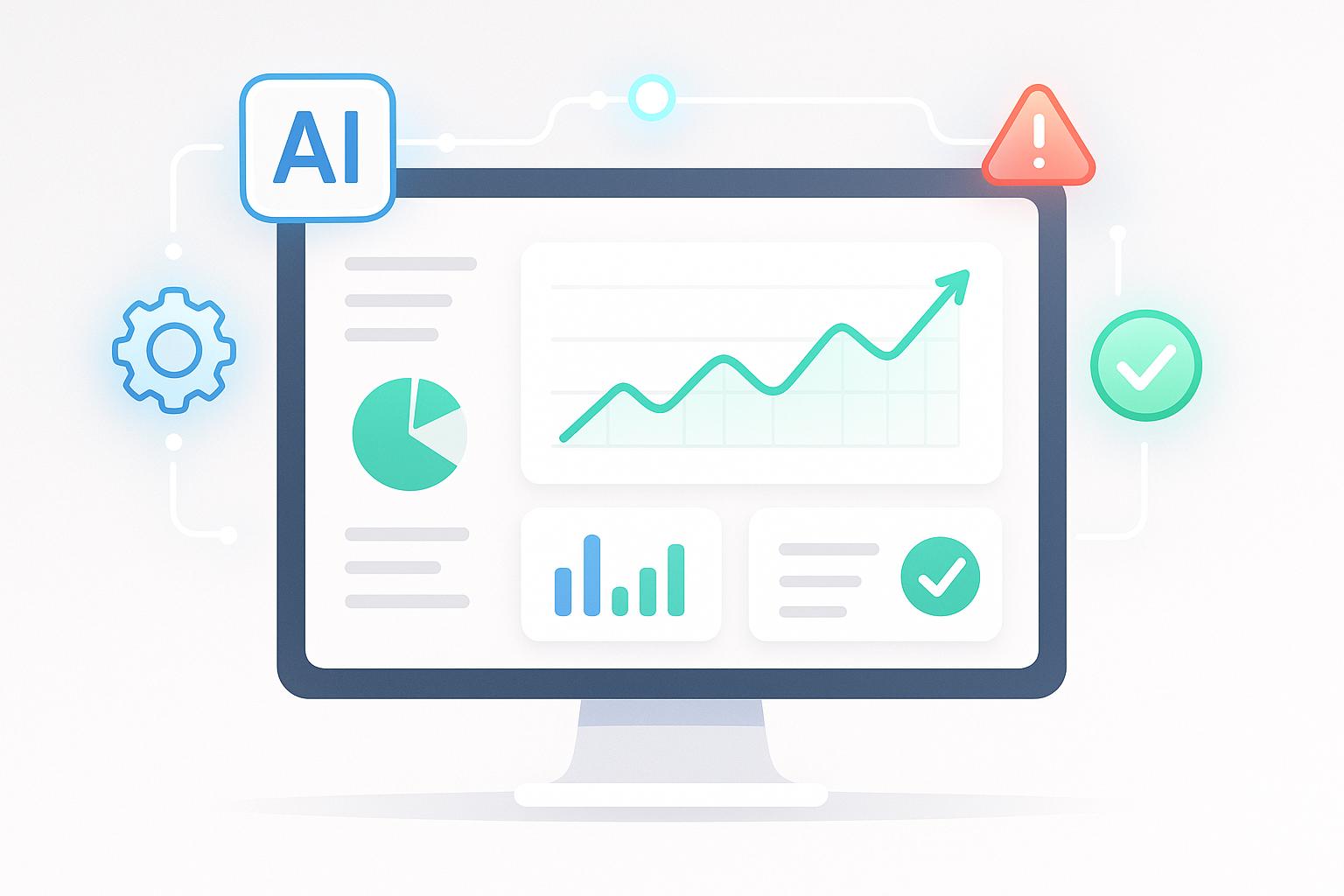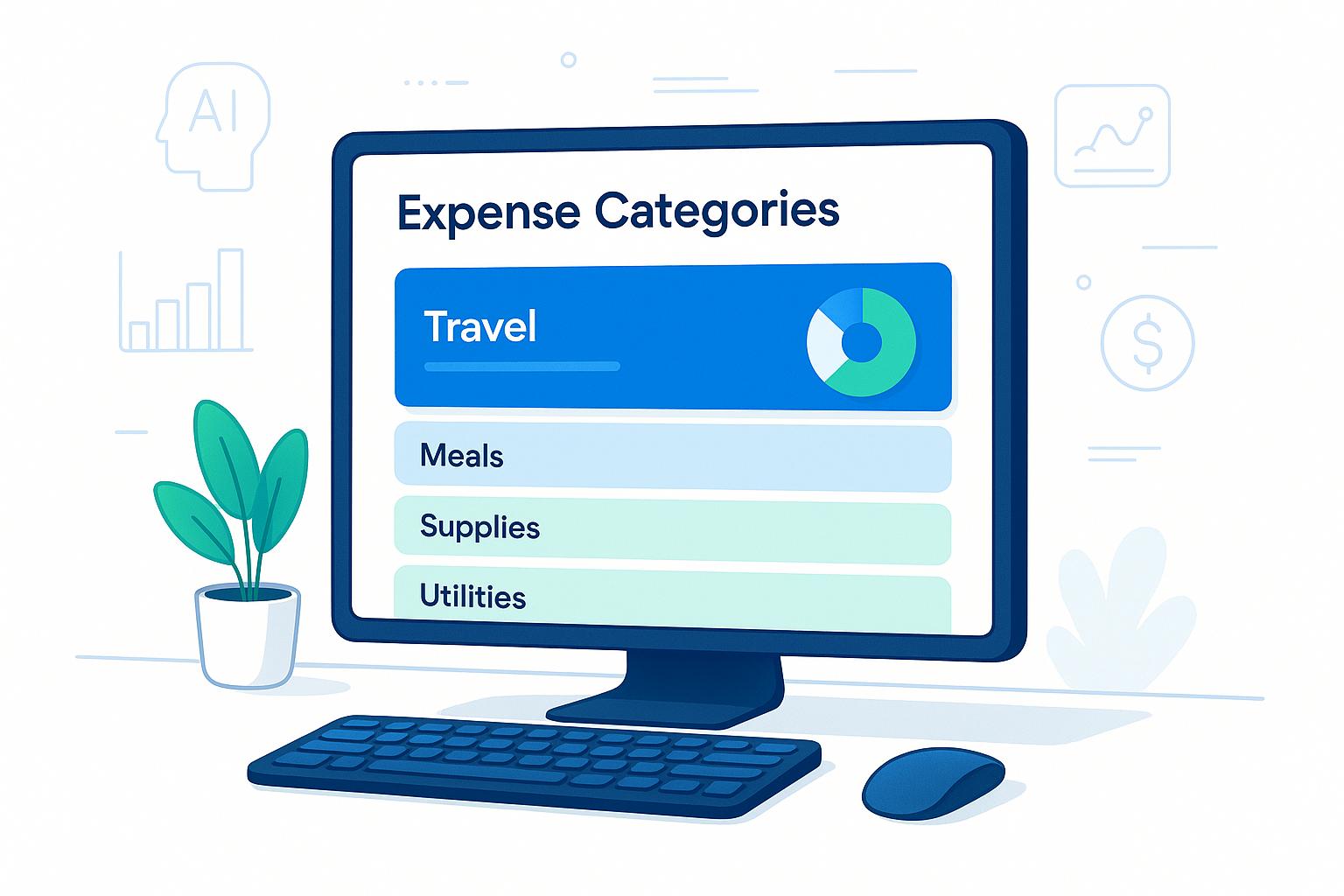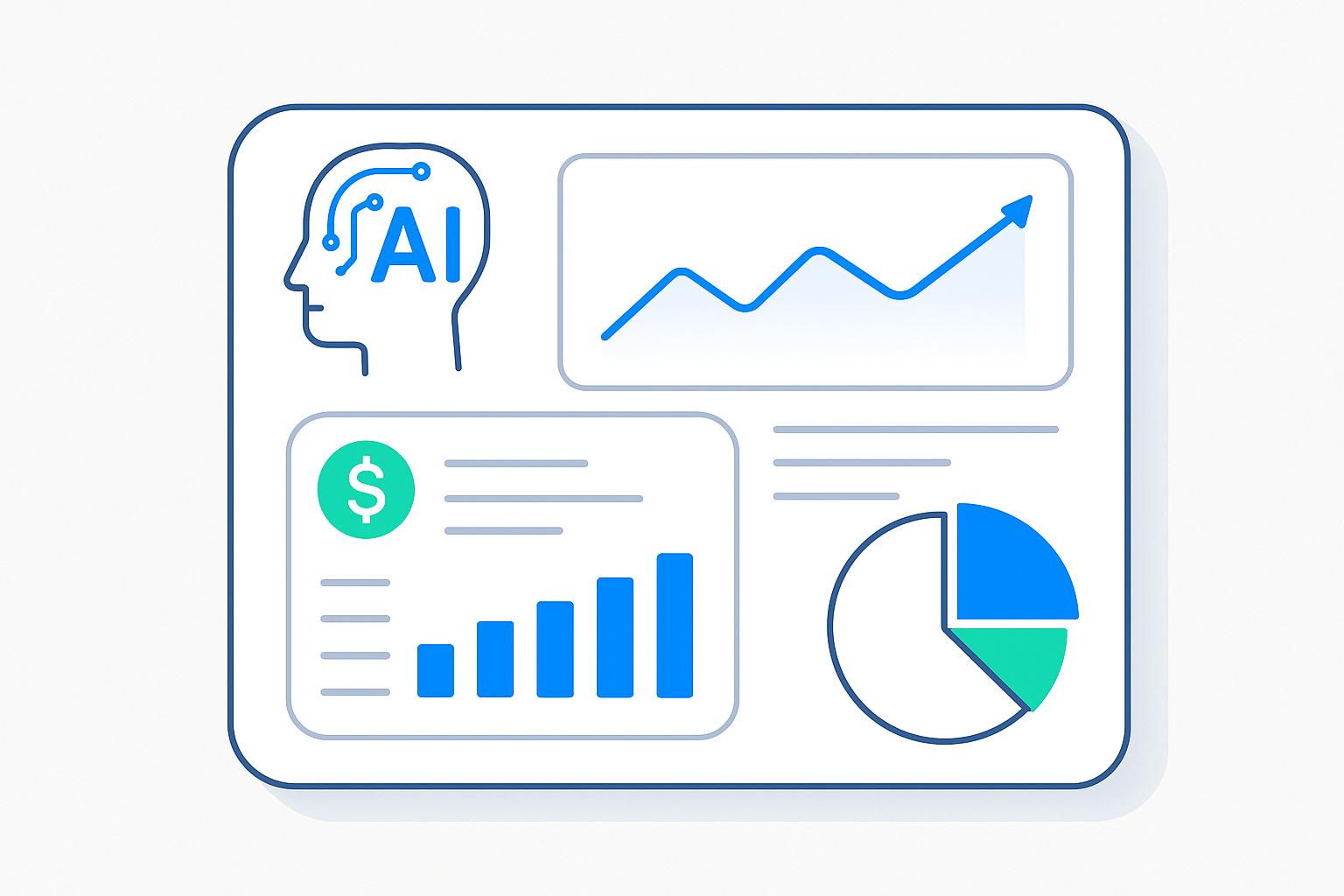AI revenue models are changing how small businesses and startups succeed in niche markets. Here’s what you need to know:
- AI Revenue Models: Use AI to create, deliver, and capture value through automation, real-time insights, and smarter decision-making.
- Why Niche Markets Matter: Less competition, better customer loyalty, and tailored solutions make niche markets profitable.
- Key Revenue Models:
- Subscription: AI improves customer retention and adjusts pricing based on usage.
- Freemium/Pay-Per-Use: Low entry cost models that use AI to analyze behavior and drive upgrades.
- AI-as-a-Service: Offers industry-specific AI tools with value-based pricing and usage-based options.
- Challenges: Poor data quality, legal/ethical risks, and unrealistic expectations can hinder success.
- Success Steps: Focus on clean data, realistic pricing, and tracking key metrics like Customer Lifetime Value (LTV) and Customer Acquisition Cost (CAC).
Quick Tip: Tools like Lucid Financials help small businesses simplify AI-driven financial planning and maximize revenue potential.
Financial Modeling for Startups: Explained
Main AI Revenue Models for Niche Markets
AI-driven revenue models are proving to be game-changers for niche markets, offering ways to boost profitability through automation and tailored solutions. Let’s break down some of the most effective models and how they’re applied.
Subscription Models
Subscription-based models thrive in niche markets by tailoring pricing and reducing churn. With AI, businesses can analyze customer behavior to refine their offerings and ensure long-term engagement. A great example is Lucid Financials, which uses a tiered subscription system. Their free-to-enter plan gradually scales to enterprise-level solutions, each tier powered by AI to address specific needs.
Here’s how AI enhances subscription models:
- Anticipates customer needs to proactively reduce churn
- Adjusts pricing tiers based on real usage data
- Customizes features for distinct customer groups
- Automates customer support for better engagement
"In vertical SaaS, AI is making previously unprofitable markets viable by increasing customer value and driving down costs. With AI automating complex tasks and delivering personalized solutions, software companies can now serve smaller, niche markets that were once financially out of reach."
– Antwyne DeLonde, VisionX founder and CEO
The next step? Models that lower entry barriers with free trials and pay-as-you-go options.
Freemium and Pay-Per-Use Models
Freemium and pay-per-use strategies leverage AI to analyze user behavior and drive upgrades. These models are especially useful in niche markets, where customers often want to experience value before committing to paid plans.
| Model Type | AI Application | Benefits |
|---|---|---|
| Freemium | Analyzing user behavior, optimizing features | Low entry barrier, data collection opportunities |
| Pay-Per-Use | Predicting usage, allocating resources | Scalable, aligns costs with value |
| Hybrid | Combining analytics, personalized pricing | Broader market appeal, better conversions |
Take Spotify as an example. By analyzing user preferences and listening habits, they create personalized experiences that encourage free users to upgrade to premium plans. This kind of flexibility is essential for niche markets.
Now, let’s look at how AI-as-a-Service models are opening up even more opportunities.
AI-as-a-Service Models
AIaaS solutions are transforming how niche businesses access advanced tools, especially in markets where traditional approaches were too costly.
"Many companies decided that this sector of niche markets was not worth the focus required to achieve economies of scale and instead looked at larger and more lucrative markets. In addition, customer service and support in these smaller markets would often require costly manual processes that made it difficult for these operations to be sustainable. AI's capability to both automate and optimize these processes means that software companies can now serve much smaller, niche segments of the market profitably."
– Siddharth Parakh, senior engineering manager at Medable
With AI, businesses can dramatically increase revenue per customer - from $1,000 to $10,000 monthly - turning a $120M market into a $1.2B opportunity. Here’s how to implement AIaaS effectively:
-
Value-Based Pricing Structure
Charge based on the measurable results customers gain, rather than just operational costs. This requires clear metrics and regular performance reviews. -
Usage-Based Components
Offer pricing tied to actual usage, like API calls or compute time, ensuring accessibility for businesses of all sizes. -
Customization Options
Provide industry-specific features and integrations that cater to unique market needs, all while keeping costs manageable through AI-driven automation.
Setting Up AI Revenue Models
Implementing AI revenue models in niche markets requires careful planning. In 2023, only 32% of SaaS companies had clear strategies for monetizing AI features.
Steps for Market Analysis
To position yourself effectively and set clear growth goals, start with a thorough market analysis. Here's how:
-
Customer Value Assessment
- Review your current revenue streams.
- Pinpoint customer pain points that AI can address.
- Estimate the value your AI solutions could bring.
-
Competition Analysis
- Study existing solutions in the market.
- Identify gaps that your AI model can fill.
- Analyze competitors' pricing to refine your approach.
"Many brands get lost trying to be everything to everyone. Niche marketing emphasizes authenticity and direct relevance - two factors essential for long-term traction." - Emulent's marketing strategist
Once you've gathered insights, the next step is selecting AI tools that fit seamlessly into your existing systems.
Choosing the Right AI Tools
Picking the right AI tools is key to building a solid revenue model. Evaluate tools based on:
| Factor | What to Look For | Why It Matters |
|---|---|---|
| Integration Capability | Check API flexibility and compatibility with your tech stack | Saves time and reduces costs. |
| Pricing Structure | Compare usage-based versus subscription models | Impacts customer acquisition and retention. |
| Scalability | Assess resource needs and performance metrics | Ensures long-term feasibility. |
A great example is Lucid Financials, which successfully implemented a tiered pricing model and integrated effortlessly with tools like QuickBooks and payroll systems.
After selecting your tools, focus on building a strong data infrastructure to support them.
Data Infrastructure Essentials
A reliable data setup is the backbone of any AI revenue model. Prioritize these key elements:
-
Data Collection Framework
- Track metrics like customer acquisition, conversion, and retention.
- Regularly audit your data for accuracy.
-
Financial Integration
- Sync with critical financial tools, such as payment processors, accounting software, and CRM platforms.
- Enable real-time tracking and quick adjustments.
-
Monitoring Systems
- Create dashboards to monitor KPIs and revenue metrics.
- Develop cash flow forecasting models that clearly separate fixed and variable costs.
"We've seen clients reduce months of trial-and-error to a few weeks using generative AI for initial niche brainstorming. It's critical to keep a human touch, but AI speeds up the early-stage ideation substantially." - Emulent's lead consultant
Make sure to maintain a financial runway of 6–12 months and regularly verify your data's accuracy. This ensures your AI-driven revenue forecasting stays reliable and effective.
sbb-itb-17e8ec9
Common AI Revenue Model Problems
Once AI revenue models are up and running, tackling common challenges is key to keeping them effective. For example, poor data quality can be a costly issue, with companies losing up to 6% of their annual revenue because of it.
Data Quality Issues
Low-quality data can derail even the best AI revenue models. In fact, data scientists spend a staggering 67% of their time cleaning and preparing data instead of focusing on building or improving AI systems. Here are some typical problems and how companies address them:
| Challenge | Impact | Solution |
|---|---|---|
| Incomplete Data | Missing values affect 15% of customer databases | AI-based cleaning reduces gaps to 2% |
| Duplicate Records | Skews revenue predictions | Automated tools remove duplicates with 95% accuracy |
| Outlier Detection | Throws off financial forecasts | AI flags 90% of anomalies automatically |
Maintaining clean data isn’t just about accuracy - it also involves handling it responsibly, which ties into legal and ethical considerations.
Legal and Ethics Guidelines
Trust is crucial when it comes to AI, and ethical practices are a big part of earning it. Companies need to balance innovation with responsibility, especially when dealing with sensitive customer data. This means using robust encryption, controlling access, and anonymizing data where necessary. Regularly testing for bias in machine learning algorithms is also critical. Tools like IBM's AI Fairness 360 can help ensure AI systems don’t unfairly favor certain groups.
"Humans find it hard to trust a black box – and understandably so. AI has a spotty record on delivering unbiased decisions or outputs." - Donncha Carroll, partner and chief data scientist at Lotis Blue Consulting
Setting Clear Expectations
AI can deliver measurable benefits, but setting realistic expectations is vital. For instance, 91% of small and medium-sized businesses (SMBs) using AI report revenue growth. Successful implementations often achieve results like:
- 30% reduction in operational costs through AI-driven anomaly detection
- 50% improvement in data accuracy and completeness
- 70% decrease in manual data-cleaning efforts
"AI is leveling the playing field between SMBs and larger enterprises. Small and medium-sized businesses using AI see real returns across their operations, from improved efficiency to stronger customer relationships. Those who wait too long to invest risk falling behind as early adopters build their advantage." - Kris Billmaier, EVP, Salesforce
To keep progress on track, organizations should:
- Continuously monitor performance against benchmarks
- Clearly communicate what AI can and cannot do
- Offer ongoing training for AI tools
- Include human oversight in critical decisions
- Dedicate resources to managing data quality - errors in data have cost companies an average of $406 million annually
Performance Tracking and Updates
Tracking AI-driven revenue accurately requires using data-focused metrics and making regular updates. Research shows that 91% of SMBs leveraging AI report revenue growth, highlighting the importance of consistent monitoring to sustain this progress.
Key Metrics to Monitor
Tracking the right metrics is essential for evaluating performance. Two critical ones are Customer Lifetime Value (LTV) and Customer Acquisition Cost (CAC). These metrics are crucial for assessing the success of AI revenue strategies. Here's how LTV is typically calculated, depending on the business model:
| Model Type | LTV Calculation Method | Key Considerations |
|---|---|---|
| Subscription | Monthly Revenue ÷ Churn Rate | Focus on recurring revenue trends |
| Non-subscription | (Avg Order Value × Expected Purchases) × Engagement Time | Monitor purchase frequency |
| Hybrid | Combined calculation from all revenue streams | Consider multiple income sources |
For healthy growth, the CAC should always be much lower than the LTV. Tools like Lucid Financials simplify this process by providing real-time financial insights through integrations with QuickBooks and payroll systems.
Keeping Models Up-to-Date
AI revenue models need regular updates to stay accurate. Dan Atkinson, COO & Co-Founder of Salesforce SMB customer MedLogiq, explains:
"Some people don't really understand how data is going to impact the business in the future. It's about how this data will be valuable to the company five years down the road. We want to make sure we're not losing that information."
Here’s how businesses can ensure their models stay effective:
1. Watch for Model Drift
Regularly check performance to catch accuracy drops. For instance, if a fraud detection model's accuracy falls from 98% to 90%, it's time to retrain.
2. Set Up Automated Monitoring
Use systems that track performance indicators and flag issues. These systems should include:
- Real-time performance tracking
- Anomaly detection
- Data quality checks
- Resource usage monitoring
3. Schedule Regular Retraining
Update models with new data when major market changes occur, customer behaviors shift, performance declines, or during quarterly reviews.
Frequent updates not only keep models accurate but also prepare businesses for scaling operations effectively.
Planning for Growth
Research reveals that 87% of SMBs using AI report smoother scaling, and 86% notice better margins. Early adoption of AI proves to be a key driver of growth for SMBs.
To scale efficiently:
- Build monitoring systems that can handle increasing data volumes.
- Tie AI metrics to broader business KPIs to measure success.
- Keep detailed logs of model inputs and outputs for transparency.
- Automate resource scaling during high-demand periods.
Data management is becoming a top priority for growing SMBs, with 74% boosting their investments in this area compared to just 47% of shrinking businesses. A strong focus on data quality is the cornerstone for scaling AI revenue models successfully.
Conclusion
The AI revenue landscape for niche markets is growing fast. For example, the generative AI market is expected to hit $37.89 billion by 2025, with a projected annual growth rate of 44.20% through 2034. This opens up new opportunities for businesses to create focused AI solutions.
Summary and Action Items
AI-focused companies allocated over 20% of their 2022 EBIT to AI initiatives. Based on the models discussed, here are the key steps for implementing AI revenue strategies successfully. Leading companies grow revenue by launching new units (23%), expanding core revenue streams (27%), and improving existing AI products (30%). In contrast, others prioritize cost-cutting measures (33%).
Striking the right balance is crucial for success. Take Klarna, for instance - their AI-powered customer service managed 2.3 million conversations, generating an additional $40 million in profit.
"Like the internet or electricity, AI will become an invisible driver of outcomes, not a selling point" - Tom Biegala, cofounder of Bison Ventures
This highlights the importance of delivering practical, results-driven solutions rather than marketing AI as a standalone feature.
Key Success Factors
-
Value-Based Pricing
Adjust pricing strategies to match the value delivered to customers while maintaining profitability. Even a 1% price increase - without losing sales - can raise operating profits by nearly 9%. -
Technology Selection
Choose the right technology for your needs and budget. For example, closed-source models like GPT-4o cost $0.0145 per call, while open-source alternatives like Llama 3.1 BB are priced at $0.00032 per call. -
Market Adaptation
Stay flexible and responsive to market demands. For instance, Jenni AI grew its monthly recurring revenue from $2,000 to $150,000 in just 18 months by focusing on customer needs and adaptability.
These steps form a practical roadmap for leveraging AI in niche markets. Startups and SMBs can also benefit from AI-powered financial planning platforms like Lucid Financials (https://lucid.now), which provide real-time insights and simplify financial management to support advanced revenue models.
The future of AI revenue strategies lies in delivering ongoing value, creating targeted solutions, and adopting flexible pricing strategies. These principles ensure that startups and SMBs can stay competitive and thrive in specialized markets.


